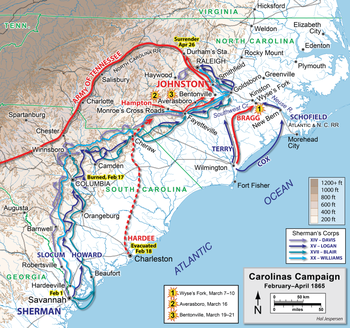 |
| Sherman and his staff |
Upon the completion of Sherman's march to the sea, Ulysses Grant planned to embark that Union army on ships and take them from Georgia up to Virginia, to deal with the army of Robert E. Lee, the last major Confederate force. But Sherman had a different idea. He got Grant's approval of a plan to march to Virginia overland through North and South Carolina and destroying along the way anything of use to the Confederacy, like he had done to Georgia. In January Sherman set out with over 60,000 men. There were few Confederates to resist him – the remnants of the Army of the Tennessee were down below 10,000 men.

The first major target on Sherman's path was Columbia, the capitol of South Carolina. This was a particularly important goal for the Federals, as South Carolina had been the first state to secede from the Union. In their path were around 1,200 Confederates under Lafayette McLaws. His men were guarding the crossing of the Salkehatchie River, but Sherman's men just built a bridge and outflanked the rebel force.
 |
| Columbia burning |
On February 17, Columbia surrendered to Sherman's advancing men, and the Confederate cavalry abandoned the city. That night chaos broke out among the freed slaves and Union soldiers and freed prisoners, fueled with plentiful supplies of alcohol. A hard wind was blowing, and when fires broke out much of the city was destroyed. It is unlikely that these were lit under orders of the Federal high command, but Sherman certainly was not sorry it happened. The next day the Union troops destroyed anything left in the city of military value.
 |
| Ruins of Columbia |






0 comments:
Post a Comment